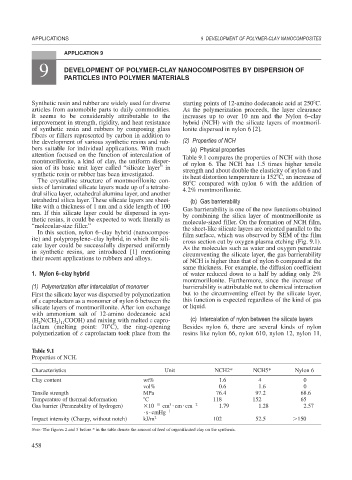Page 486 - Book Hosokawa Nanoparticle Technology Handbook
P. 486
APPLICATIONS 9 DEVELOPMENT OF POLYMER-CLAY NANOCOMPOSITES
APPLICATION 9
9 DEVELOPMENT OF POLYMER-CLAY NANOCOMPOSITES BY DISPERSION OF
PARTICLES INTO POLYMER MATERIALS
Synthetic resin and rubber are widely used for diverse starting points of 12-amino dodecanoic acid at 250 C.
articles from automobile parts to daily commodities. As the polymerization proceeds, the layer clearance
It seems to be considerably attributable to the increases up to over 10 nm and the Nylon 6–clay
improvement in strength, rigidity, and heat resistance hybrid (NCH) with the silicate layers of montmoril-
of synthetic resin and rubbers by composing glass lonite dispersed in nylon 6 [2].
fibers or fillers represented by carbon in addition to
the development of various synthetic resins and rub- (2) Properties of NCH
bers suitable for individual applications. With much (a) Physical properties
attention focused on the function of intercalation of Table 9.1 compares the properties of NCH with those
montmorillonite, a kind of clay, the uniform disper- of nylon 6. The NCH has 1.5 times higher tensile
sion of its basic unit layer called “silicate layer” in strength and about double the elasticity of nylon 6 and
synthetic resin or rubber has been investigated. its heat distortion temperature is 152 C, an increase of
The crystalline structure of montmorillonite con- 80 C compared with nylon 6 with the addition of
sists of laminated silicate layers made up of a tetrahe- 4.2% montmorillonite.
dral silica layer, octahedral alumina layer, and another
tetrahedral silica layer. These silicate layers are sheet- (b) Gas barrierability
like with a thickness of 1 nm and a side length of 100 Gas barrierability is one of the new functions obtained
nm. If this silicate layer could be dispersed in syn- by combining the silica layer of montmorillonite as
thetic resins, it could be expected to work literally as molecule-sized filler. On the formation of NCH film,
“molecular-size filler.” the sheet-like silicate layers are oriented parallel to the
In this section, nylon 6–clay hybrid (nanocompos- film surface, which was observed by SEM of the film
ite) and polypropylene–clay hybrid, in which the sili- cross section cut by oxygen plasma etching (Fig. 9.1).
cate layer could be successfully dispersed uniformly As the molecules such as water and oxygen penetrate
in synthetic resins, are introduced [1] mentioning circumventing the silicate layer, the gas barrierability
their recent applications to rubbers and alloys.
of NCH is higher than that of nylon 6 compared at the
same thickness. For example, the diffusion coefficient
1. Nylon 6–clay hybrid of water reduced down to a half by adding only 2%
montmorillonite. Furthermore, since the increase of
(1) Polymerization after intercalation of monomer barrierability is attributable not to chemical interaction
First the silicate layer was dispersed by polymerization but to the circumventing effect by the silicate layer,
of caprolactam as a monomer of nylon 6 between the this function is expected regardless of the kind of gas
silicate layers of montmorillonite. After ion exchange or liquid.
with ammonium salt of 12-amino dodecanoic acid
(H N(CH ) COOH) and mixing with melted capro- (c) Intercalation of nylon between the silicate layers
2
2 11
lactam (melting point: 70 C), the ring-opening Besides nylon 6, there are several kinds of nylon
polymerization of caprolactam took place from the resins like nylon 66, nylon 610, nylon 12, nylon 11,
Table 9.1
Properties of NCH.
Characteristics Unit NCH2* NCH5* Nylon 6
Clay content wt% 1.6 4 0
vol% 0.6 1.6 0
Tensile strength MPa 76.4 97.2 68.6
Temperature of thermal deformation C 118 152 65
3
Gas barrier (Permeability of hydrogen) 10 11 cm
cm
cm 2 1.79 1.28 2.57
s
cmHg 1
Impact intensity (Charpy, without notch) kJ/m 2 102 52.5 150
Note: The figures 2 and 5 before * in the table denote the amount of feed of organificated clay on the synthesis.
458

